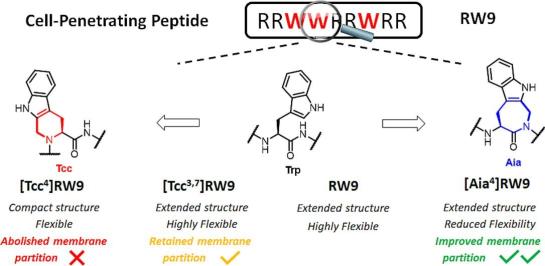
Over the past decades, many cell-penetrating peptides (CPP) have been studied for their capacity to cross cellular membranes, mostly in order to improve cellular uptake of therapeutic agents. Even though hydrophobic and anionic CPPs have been described, many of them are polycationic, due to the presence of several arginine (Arg) residues. Noteworthy, however, the presence of aromatic amino acids such as tryptophan (Trp) within CPPs seems to play an important role to reach high membranotropic activity. RW9 (RRWWRRWRR) is a designed CPP derived from the polyarginine R9 presenting both features. In general, when interacting with membranes, CPPs adopt an optimal conformation for membrane interactions – an amphipathic helical secondary structure in the case of RW9. Herein, we assumed that the incorporation of a locally constrained amino acid in the peptide sequence could improve the membranotropic activity of RW9, by facilitating its structuration upon contact with a membrane, while leaving a certain plasticity. Therefore, two cyclized Trp derivatives (Tcc and Aia) were synthesized to be incorporated in RW9 as surrogates of Trp residues. Thus, a series of peptides containing these building blocks has been synthesized by varying the type, position, and number of modifications. The membranotropic activity of the RW9 analogs was studied by spectrofluorescence titration of the peptides in presence of liposomes (DMPG), allowing to calculate partition coefficients (Kp). Our results indicate that the partitioning of the modified peptides depends on the type, the number and the position of the modification, with the best sequence being [Aia4]RW9. Interestingly, both NMR analysis and molecular dynamic (MD) simulations indicate that this analog presents an extended conformation similar to the native RW9, but with a much-reduced structural flexibility. Finally, cell internalization properties were also confirmed by confocal microscopy.
